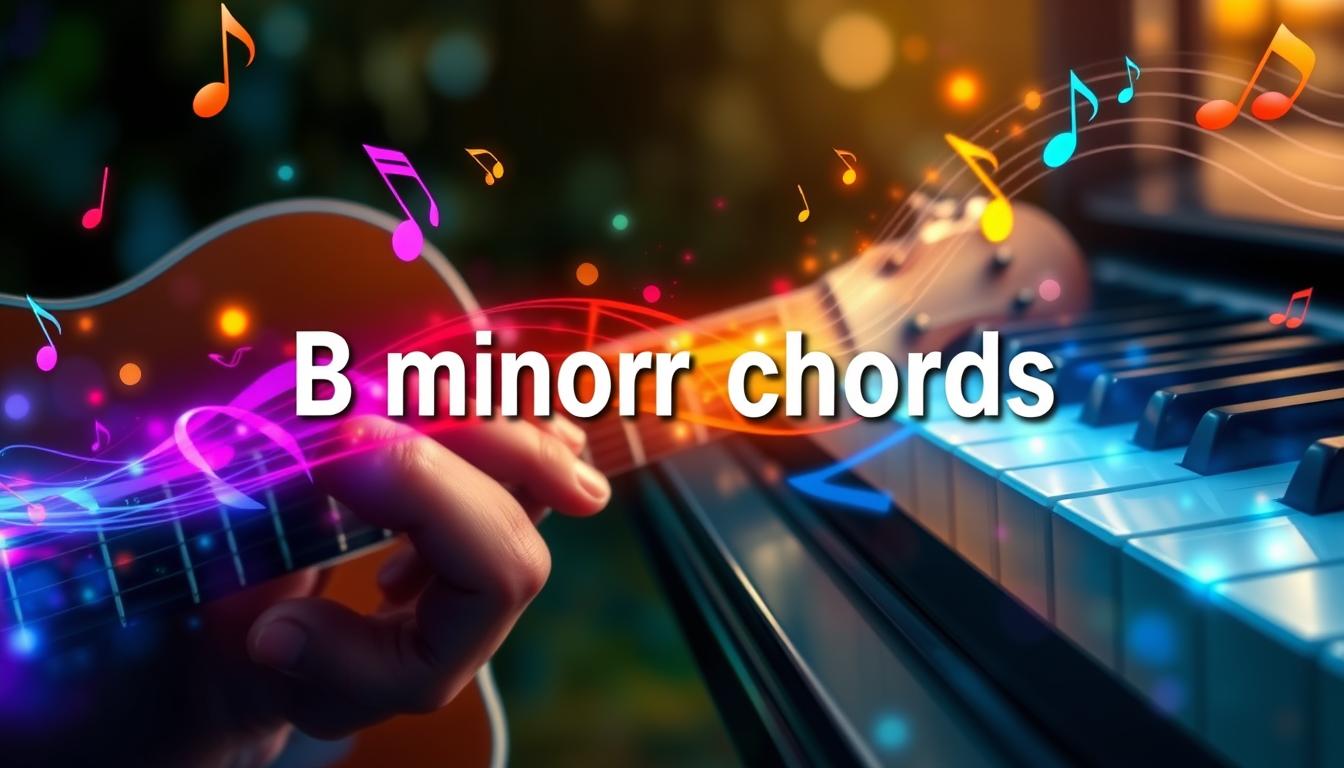The B minor chord is a key element in music. It’s used in many genres, from classical to pop.
Learning this chord can expand your musical skills. This guide will teach you how to play B minor on guitar and piano.
We’ll cover different versions and share helpful tips. By the end, you’ll be on your way to mastering B minor.
“An artistic representation of a B minor chord, featuring a guitar and piano in a harmonious setting, with emphasis on the finger placements on the guitar fretboard and the piano keys, showcasing musical notes and symbols subtly in the background, vibrant colours and textures capturing the essence of music.”
What is a B Minor Chord?
The B minor chord consists of B, D, and F# notes. It’s known for its sombre and introspective musical qualities.
This chord is crucial in classical, folk, and rock genres. It creates a reflective atmosphere in musical compositions.
B minor is the sixth chord in the G primary key. It serves as a pivot between major and minor tonalities.
Understanding the B minor chord is vital for musicians. It helps unlock new creative possibilities in music.
How to Form a B Minor Chord on Guitar
The b minor guitar chord is key for aspiring guitarists. It adds depth to folk, rock, and classical music.
Start by placing your fretting hand on the second fret. Put your index finger on the second string.
Next, place your middle finger on the third string. Your ring finger goes on the fourth string.
Press down on the strings with your fingers straight. Keep your wrist relaxed and your elbow close to your body.
If it’s hard, try different finger positions. Some use their pinky on the fifth string instead.
Practice switching between b minor and other chords quickly and often. This will boost your musical skills.
Playing the B Minor Chord on Piano
The B minor piano chord is vital for pianists. It’s used in many music styles, from classical to pop.
Place your left hand on B, D, and F# for the B minor chord. Your right hand goes on B, F#, and D. This creates a rich sound.
Rearranging the notes creates chord inversions. These add depth to your playing. Try the first inversion with F# as the lowest note.
Practice is key to mastering the B minor chord. Start slow, focusing on the hand position. Gradually speed up as you get comfortable.
Use the chord in simple progressions. This will help you improve your skills and understanding. Keep practising to become a better pianist.
Chord Progressions Featuring B Minor
The B minor chord adds depth to many popular songs. It brings emotion to chord progressions in rock and pop music.
Leonard Cohen’s “Hallelujah” uses B minor. Coldplay’s “Viva la Vida” also features this chord.
B minor can create tension in your musical pieces. It often works as the relative minor of D major.
Try different chord sequences with B minor. This can help you make music that moves people.
Learn to play B minor on guitar or piano. It will open up new ways to write songs.
B Minor Variations
B minor chord has several interesting variations. The B minor seven chord adds the seventh interval. It creates a melancholic mood in ballads and indie tracks.
The B minor nine chord includes the ninth interval, producing a more prosperous, atmospheric sound. These variations are common in jazz, film scores, and progressive rock.
A vibrant and artistic representation of the B minor chord variations, featuring a lush guitar and piano backdrop, surrounded by colourful musical notes and abstract shapes symbolizing harmony and rhythm. Include various finger placements on guitar fretboards, and piano keys illuminated in a soft glow, all set against a dreamy, blurred musical landscape.
Learning B minor chord variations opens up new creative possibilities. Try adding seventh or ninth intervals to the basic B minor chord.
Listen to how these changes affect the mood of your music. With practice, you’ll easily use these chords in your songs.
Tips for Mastering B Minor on Guitar
Mastering the B minor chord takes practice and the proper techniques. Build finger strength with exercises to play it easily.
Try the “spider walk” to move fingers up and down strings. This helps keep each finger strong and independent.
Practice chord changes to improve finger movements. Start slowly and increase speed as you improve.
Learn proper finger positioning for the B minor chord. Place your thumb behind the neck.
Curve your fingers and press firmly on the strings. Try different hand positions to find what works best.
Consistent practice is key to mastering the B minor chord. Set aside daily time for guitar practice.
Don’t get discouraged if progress is slow. With patience, you’ll play B minor like a pro.
Tips for Mastering B Minor on Piano
Learning the B minor chord on the piano can be fun. Here are some tips to help you get better at it.
Focus on piano exercises for your left hand. Practice arpeggios and scales in B minor to build skill.
Set aside time each day to work on these exercises. Repetition will help you improve faster.
Master the sustain pedal techniques for a rich sound. Try different pedal patterns to create the right balance.
Play sheet music with lots of B minor chords. This will help you use your new skills.
Look for classical, jazz, or modern pieces to challenge yourself. Keep practising and trying new songs to improve.

B Minor in Different Music Genres
The B minor chord is versatile and used in many music genres. It brings unique emotions and applications to each style of music.
In classical music, B minor often conveys deep feelings and sadness. Composers use it to create haunting and thoughtful pieces.
Beethoven’s “Moonlight Sonata” and Chopin’s Prelude in B minor are famous examples. These works show how complex B minor can be in classical music.
Rock and pop artists use B minor for powerful, emotional songs. Deep Purple’s “Smoke on the Water” and Jimi Hendrix’s “Purple Haze” feature this chord.
In jazz, B minor creates tension and allows for improvisation. It’s used in standards like “All the Things You Are” and “Autumn Leaves”.
These jazz songs use B minor for complex harmonies. This leads to impressive solos that captivate listeners.
Troubleshooting Common Issues
Playing the B minor chord can be tricky for musicians. Let’s look at some issues and solutions.
Chord fingering on the guitar can be tricky. The B minor chord needs careful finger placement.
Practice slowly to get it right. Focus on correct finger positions and keeping your hand relaxed.
Smooth strumming on the guitar can be tricky, too. The B minor chord might feel awkward at first.
Try different strumming methods. Use a pick or your thumb and practice various patterns slowly.
Moving between chords can be challenging on the piano. Break down the chord into separate notes.
Practice moving from one chord to another. Focus on smooth hand movements and proper fingering.
Keep practising these tips. Soon, you’ll play the B minor chord with ease.
Additional Resources
Learn the B minor chord with online resources. From tutorials to apps, there’s plenty to help you grow.
YouTube offers excellent chord tutorials for all levels. These videos show how to play B minor on guitar and piano.
Music learning apps provide interactive lessons and progress tracking. They make learning B minor fun and easy.
Books on music theory can deepen your chord knowledge. They explain B minor’s role in the musical world.
Practice often to master the B minor chord. With the right tools, you’ll become a skilled player.
Encouragement for Practice
Mastering the B minor chord takes time and practice. Set achievable music practice goals and celebrate your progress.
Your confidence will grow as you improve your technique. Each step forward deepens your appreciation for the instrument.
The benefits of regular practice go beyond playing the B minor chord. It enhances cognitive function and improves dexterity.
Consistent practice also fosters focus and discipline. These skills can benefit you in many ways.
Learning an instrument is a lifelong journey. It’s full of challenges and moments of triumph.
Embrace the process and celebrate your wins. With dedication, you’ll unlock the B minor chord’s potential.
Keep practising and enjoy the music. Your skills will continue to grow.
FAQ
What is a B Minor Chord?
A B minor chord has three notes: B, D, and F#. It sounds darker and more melancholic than major chords.
Many genres, like classical, rock, and pop music, use this chord.
How do I play the B Minor Chord on Guitar?
Place your index finger on the A string’s second fret. Put your middle finger on the D string’s third fret.
Your ring finger goes on the G string’s fourth fret. Try other finger positions for different sounds.
How do I play the B Minor Chord on Piano?
Use your left hand. Place your thumb on B, index finger on D, and middle finger on F#.
Try different note orders for inversions. Practice smooth transitions between chords.
What are some Chord Progressions Featuring B Minor?
Common progressions include i-IV-V-i and i-VI-III-VII. Another popular one is i-III-VI-III.
These appear in many songs across various music genres.
What are some Variations of the B Minor Chord?
Try B minor 7 (B, D, F#, A) or B minor 9 (B, D, F#, A, C#).
Another option is the B diminished chord (B, D, F). These add complexity to your music.
What are Some Tips for Mastering the B Minor Chord on Guitar?
Do exercises for finger strength. Practice chord changes and arpeggios.
Work on smooth transitions. Use a metronome to keep a steady rhythm.
What are Some Tips for Mastering the B Minor Chord on Piano?
Focus on hand position and finger placement. Practice moving between different chord inversions.
Use the sustain pedal for richer sound. Regular practice develops muscle memory.
How is the B Minor Chord Used in Different Music Genres?
Classical music uses it for sombre moods. Rock and pop use it for emotional power.
Jazz musicians use B minor to add depth to their harmonies.
What are Some Common Issues with Playing the B Minor Chord?
Finger positioning can be tricky, especially on guitar. Smooth transitions between chords are challenging.
Guitarists may struggle with reach. Pianists might have trouble coordinating both hands.
What Additional Resources are Available for Learning the B Minor Chord?
Try online tutorials, instructional books, and mobile apps. Music theory courses and video lessons are helpful.
Private lessons or joining a music community can provide personalized guidance.
You can also read more : Instagram Story Anonymous Viewer: A Comprehensive Guide



